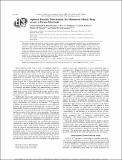Optimal Porosity Distribution for Minimized Ohmic Drop across a Porous Electrode
Author(s)
Braatz, Richard D.; Ramadesigan, Venkatasailanathan; Methekar, Ravi N.; Latinwo, Folarin; Subramaniana, Venkat R.
DownloadBraatz_Optimal porosity.pdf (223.9Kb)
PUBLISHER_POLICY
Publisher Policy
Article is made available in accordance with the publisher's policy and may be subject to US copyright law. Please refer to the publisher's site for terms of use.
Terms of use
Metadata
Show full item recordAbstract
This paper considers the design of spatially varying porosity profiles in next-generation electrodes based on simultaneous optimization of a porous-electrode model. Model-based optimal design (not including the solid-phase intercalation mechanism) is applied to a porous positive electrode made of lithium cobalt oxide, which is commonly used in lithium-ion batteries for various applications. For a fixed amount of active material, optimal grading of the porosity across the electrode was found to decrease the ohmic resistance by 15%–33%, which in turn increases the electrode capacity to hold and deliver energy. The optimal porosity grading was predicted to have 40% lower variation in the ohmic resistance to variations in model parameters due to manufacturing imprecision or capacity fade. The results suggest that the potential for the simultaneous model-based design of electrode material properties that employ more detailed physics-based first-principles electrochemical engineering models to determine optimal design values for manufacture and experimental evaluation.
Date issued
2010-10Department
Massachusetts Institute of Technology. Department of Chemical EngineeringJournal
Journal of The Electrochemical Society
Publisher
The Electrochemical Society
Citation
Ramadesigan, Venkatasailanathan et al. “Optimal Porosity Distribution for Minimized Ohmic Drop Across a Porous Electrode.” Journal of The Electrochemical Society 157.12 (2010): A1328. ©2010 ECS - The Electrochemical Society
Version: Final published version
ISSN
0013-4651